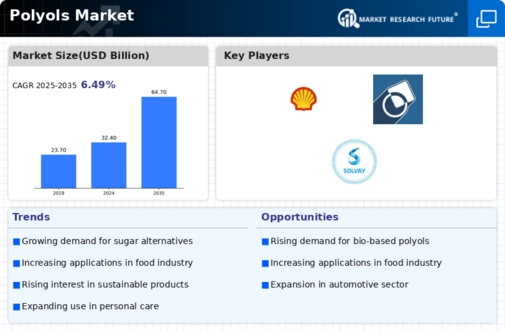Growth in the Pharmaceutical Sector
The pharmaceutical industry is increasingly utilizing polyols in various applications, which is contributing to the expansion of the Polyols Market. Polyols are often employed as excipients in drug formulations due to their favorable properties, such as stability and compatibility. In 2025, the pharmaceutical segment is expected to account for a significant share of the polyols market, driven by the rising demand for oral solid dosage forms. The versatility of polyols allows for improved drug delivery systems, enhancing patient compliance. As the pharmaceutical sector continues to innovate, the Polyols Market is likely to experience robust growth, fueled by the need for effective and patient-friendly formulations.
Sustainability Trends in Manufacturing
Sustainability is becoming a pivotal factor in manufacturing processes, influencing the Polyols Market significantly. The shift towards bio-based and renewable resources is prompting manufacturers to explore sustainable polyol production methods. In 2025, the market for bio-based polyols is anticipated to grow substantially, driven by regulatory pressures and consumer demand for environmentally friendly products. Companies are increasingly investing in research and development to create polyols derived from natural sources, which not only reduce carbon footprints but also appeal to eco-conscious consumers. This trend towards sustainability is likely to enhance the competitive landscape of the Polyols Market, as businesses that prioritize eco-friendly practices may gain a market advantage.
Increasing Use in Personal Care Products
The Polyols Market is witnessing a notable increase in the application of polyols within personal care products. These compounds are valued for their moisturizing properties and are commonly found in formulations for skin care, hair care, and cosmetics. The market for personal care products is projected to grow at a rate of 4% annually, with polyols playing a crucial role in enhancing product performance. As consumers become more aware of ingredient transparency and seek products with beneficial properties, the demand for polyols in this sector is expected to rise. This trend indicates a promising future for the Polyols Market, as manufacturers strive to meet consumer expectations for high-quality personal care solutions.
Rising Demand for Low-Calorie Sweeteners
The increasing consumer preference for low-calorie and sugar-free products is driving the Polyols Market. As health consciousness rises, many consumers are seeking alternatives to traditional sugars, which has led to a surge in the demand for polyols. In 2025, the market for sugar substitutes, including polyols, is projected to reach approximately 2.5 billion USD, reflecting a compound annual growth rate of around 5%. This trend is particularly evident in the food and beverage sector, where manufacturers are reformulating products to cater to health-conscious consumers. The Polyols Market is thus positioned to benefit from this shift, as polyols provide sweetness without the calories associated with sugar, making them an attractive option for product developers.
Technological Advancements in Production
Technological innovations in the production of polyols are reshaping the Polyols Market. Advances in manufacturing processes, such as enzymatic synthesis and fermentation technology, are enabling the production of polyols with improved efficiency and lower costs. These innovations are expected to enhance the quality and variety of polyols available in the market, catering to diverse applications across various industries. In 2025, the adoption of these advanced technologies is projected to increase, potentially leading to a more competitive market landscape. As manufacturers leverage these advancements, the Polyols Market may witness a transformation, characterized by enhanced product offerings and greater accessibility for consumers and businesses alike.

















Leave a Comment